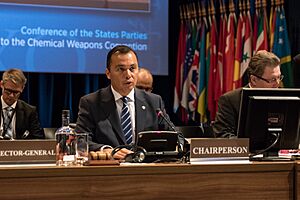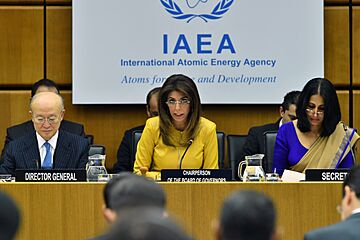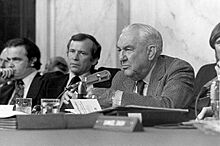Chair (officer) facts for kids

The chair (also called chairman, chairwoman, or chairperson) is the person who leads a group or meeting. Think of them as the leader of a board, a committee, or any group that meets to make decisions. This person is usually chosen by the group members. Their main job is to make sure meetings run smoothly and that the group gets its work done in an organized way.
Sometimes, the chair might also be called a president. In other groups, the president and the chair are different jobs. The word "chairman" can be used for anyone, no matter if they are a man or a woman. When someone "chairs" a meeting, it means they are leading it.
Contents
Different Names for the Leader
There are many names for the person who leads a group. These include chair, chairman, chairwoman, chairperson, convenor, facilitator, moderator, president, and presiding officer. In some parliaments, the leader is called the speaker.
The word "chair" has been used to mean a position of power since the 1600s. Some people think "chairman" sounds like it's only for men. Because of this, many groups now use "chair" or "chairperson" to be fair to everyone.
For example, in school debates, the person who controls the debate is called the chair or chairman. You might say "Madame Chair" or "Mr. Chairman" to them. Many style guides, like those for business writing, suggest using "chair" or "chairperson" today.
How We Use These Words

The word chair can also mean the actual seat or spot where the leader sits. When a meeting is happening, the person leading it is "in the chair." People usually talk to "the chair" (like "Mr. Chairman") instead of using their name. This helps the leader stay fair and neutral.
In old British music hall shows, the chairman was like the master of ceremonies. They would introduce the performers and keep the audience in line. A famous TV show in the 1960s and 70s called The Good Old Days showed this role.
The title "Chairman" became very important in some countries, especially those with socialist governments after 1917. Leaders like Vladimir Lenin in Russia were called "Chairman of the Council of People's Commissars" instead of prime minister. In China, Mao Zedong was famously known as "Chairman Mao." He was the leader of the Chinese Communist Party.
What a Chair Does
Duties in Meetings
Besides leading the group, the chair has important jobs during meetings:
- Starting the meeting on time.
- Checking if enough members are there to make decisions (this is called a quorum).
- Announcing what topics will be discussed from the agenda.
- Deciding who gets to speak.
- Making sure everyone follows the group's rules.
- Asking members to vote on ideas or motions. This is how disagreements are solved.
- Ending the meeting.
While leading, the chair should be fair and not interrupt speakers who are following the rules. In smaller groups, the chair votes like everyone else. In bigger groups, the chair usually only votes if their vote will change the outcome. The chair only gets one vote, just like other members.
Powers and Authority
How much power a chair has can be very different from one group to another. Some chairs can hire staff and make money decisions. Others only suggest ideas to a board of directors. Some chairs might only be a spokesperson for the group. The amount of power depends on the type of group and its own rules.
What Happens if a Chair Does Not Do Their Job Well
If a chair uses too much power, acts badly, or doesn't do their job, they might face consequences. These can include being told off, suspended, or even removed from their position. The group's rules explain how these actions can happen. Usually, the people who chose or elected the chair are the ones who can discipline them.
Leaders in Big Companies
In large companies, there are a few common types of chairs.
Chairman and CEO
Sometimes, the chief executive officer (CEO) is also the chair. The CEO is the top boss who runs the company every day. When this happens, the company's board often chooses another independent person to be a "lead independent director." This person helps make sure the board is fair.
Executive Chair
An executive chair is a separate job from the CEO. This person still has a lot of say in how the company runs. For example, Larry Ellison at Oracle and Steve Case at AOL Time Warner have held this role. At a company like HSBC, the group chair is seen as the most important job. They lead the board and meet with government leaders.
Non-executive Chair
A non-executive chair is also a separate job from the CEO. But unlike an executive chair, this person does not get involved in the company's daily work. Many companies around the world have separated these two roles. They believe it helps the company be run better.
The non-executive chair's main jobs are usually about the board itself:
- Leading the board meetings.
- Organizing the board's activities, like setting their yearly plan.
- Checking how well the CEO and other board members are doing.
Examples

Many companies in the US have an executive chair. This is sometimes called the "American model." Having a non-executive chair is common in the UK and Canada, known as the "British model." Experts have different ideas about which model is better. More and more investors want companies with an executive chair to also have a lead independent director. This helps bring an independent view to the company.
Companies that have both an executive chair and a CEO include Ford, HSBC, Alphabet Inc., and HP.
Vice-chair and Deputy Chair
A vice-chair or deputy chair is a person who helps the main chair. They can take over if the chair is away or if the chair is involved in a discussion. If both the chair and vice-chair are absent, the group might choose a chair pro tempore to lead just one meeting.
In some groups, there might be many vice-chairs but only one deputy chair. In these cases, the deputy chair might be a higher rank than a vice-chair. This type of deputy chair usually gives advice but doesn't run daily operations.
See also
- Executive director
- Non-executive director
- President (corporate title)


